Last updated: 7th January 2022
We took a long weekend to beautiful Budapest – one of Europe’s most photogenic cities. We visited with our friends Paul and Anthony to enjoy bathing in the city’s famous thermal baths. In this Budapest blog post we’ll show you how to see Budapest in 2 days like we did. The top Budapest attractions – best thermal baths and the must see sights. Lots of ideas to add to your own Budapest itinerary. Or check out our suggested 2 days in Budapest itinerary at the bottom of this page.
Table of Contents
Brief History of Budapest
Budapest was once 3 separate cities – Buda, Óbuda (Old Buda) and Pest separated by the River Danube. In 1873 they merged to form Budapest – the capital city of Hungary. The city’s roots date back to a Celtic and Roman times, the Mongols and Ottomans also played a big part of Budapest’s occupation.
In more modern times between 1867 – 1918 Budapest was under the rule of the Austria-Hungary Empire. By 1948 Hungary had become a communist state of the Soviet Union’s Eastern bloc, which led to the 1956 Hungarian Revolution – an anti Soviet revolt. You can still see scars from bullet holes on buildings of this period. In 1989 the iron curtain dropped and Hungary became a democratic republic. In Budapest the communist legacy can still be seen on the streets through the cars. We saw a few parked Trabant cars and a couple of old Barkas minibuses. Some companies offer sightseeing tours using these vehicles.

Budapest’s two parts of Buda and Pest are joined together by many bridges over the River Danube

Signs of the past – a Trabant car. Budapest was once under the rule of the communist Soviet Union for 40 years

The Art Nouveau Gresham Palace now The Four Seasons luxury hotel

Budapest’s Liberty Bridge built in 1896 – one of the may bridges that connect the Buda and Pest sides together
Budapest’s Best Thermal Baths
Budapest is sometimes called ‘The City of Spas’ famous for its thermal baths and spas. There’s over 100 in Budapest to choose from! It’s one of the reasons the Romans established a city here called Aquincum. They built huge baths to enjoy the natural thermal springs, today only the ruins remain which you can see at the old Roman fortress – Thermae Maiores now the Aquincum Museum.
Bathing is a daily part of life in Budapest and is a social affair. Locals regularly bathe in the mineral rich waters to sooth their ailments. Apparently the water is really good for arthritis and joint illnesses. The bath houses are beautiful places to visit, there’s impressive spas built during the Turkish Ottoman period (1541 – 1686) and glamorous Art Nouveau baths built in the 20th century. We spent time from each of our 2 days in Budapest relaxing and indulging in the two most prestigious baths – Széchenyi and Gellért.
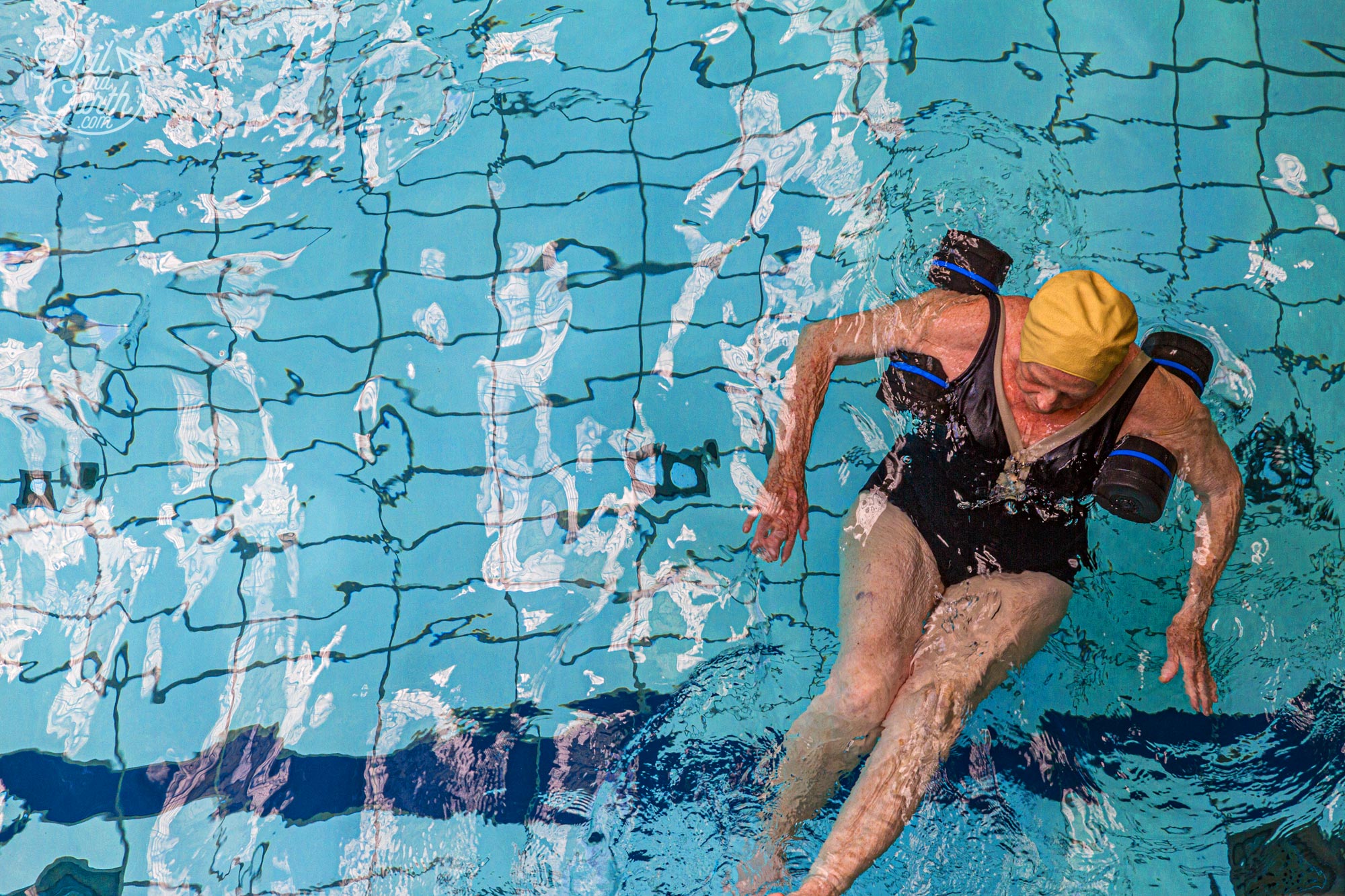
Budapest – The City of Spas
The Széchenyi Baths
Located in the City Park, The Széchenyi Baths was built in 1913 and is the largest thermal spent bath complex in Budapest and Europe. It’s neo baroque architecture is just lovely and it feels like you’re in a royal palace as soon as you step through the doors. Széchenyi Baths has 3 outdoor and 15 indoor pools with temperatures ranging from 22ºC to 38ºC. There’s also saunas and steam rooms to enjoy, all the water comes from 2 hot springs. We enjoyed relaxing in the hot water looking at all the glorious architecture around us. One of the highlights was watching people play games of chess waist high in the water. In the summer the spa holds ‘sparty’ clubbing nights which sound like great fun.
The pools are pretty busy with lots of locals and tourists, it’s the most popular of Budapest’s baths and is the top of Budapest tourist attractions. Garth loved the water jets used to massage your neck and the spiral whirlpool. Whist Phil went for a personal massage and was pummelled to within an inch of his life. He said he felt like he’d done 5 rounds with Mike Tyson! The hot water of Széchenyi and the smell of sulphur reminded us of swimming in the thermal waters of Iceland.

One of the three outdoor pools of the Széchenyi Thermal Bath

The grand entrance to The Széchenyi Baths and Spa

For more privacy when changing you can hire you’re own cabin, which you can also share
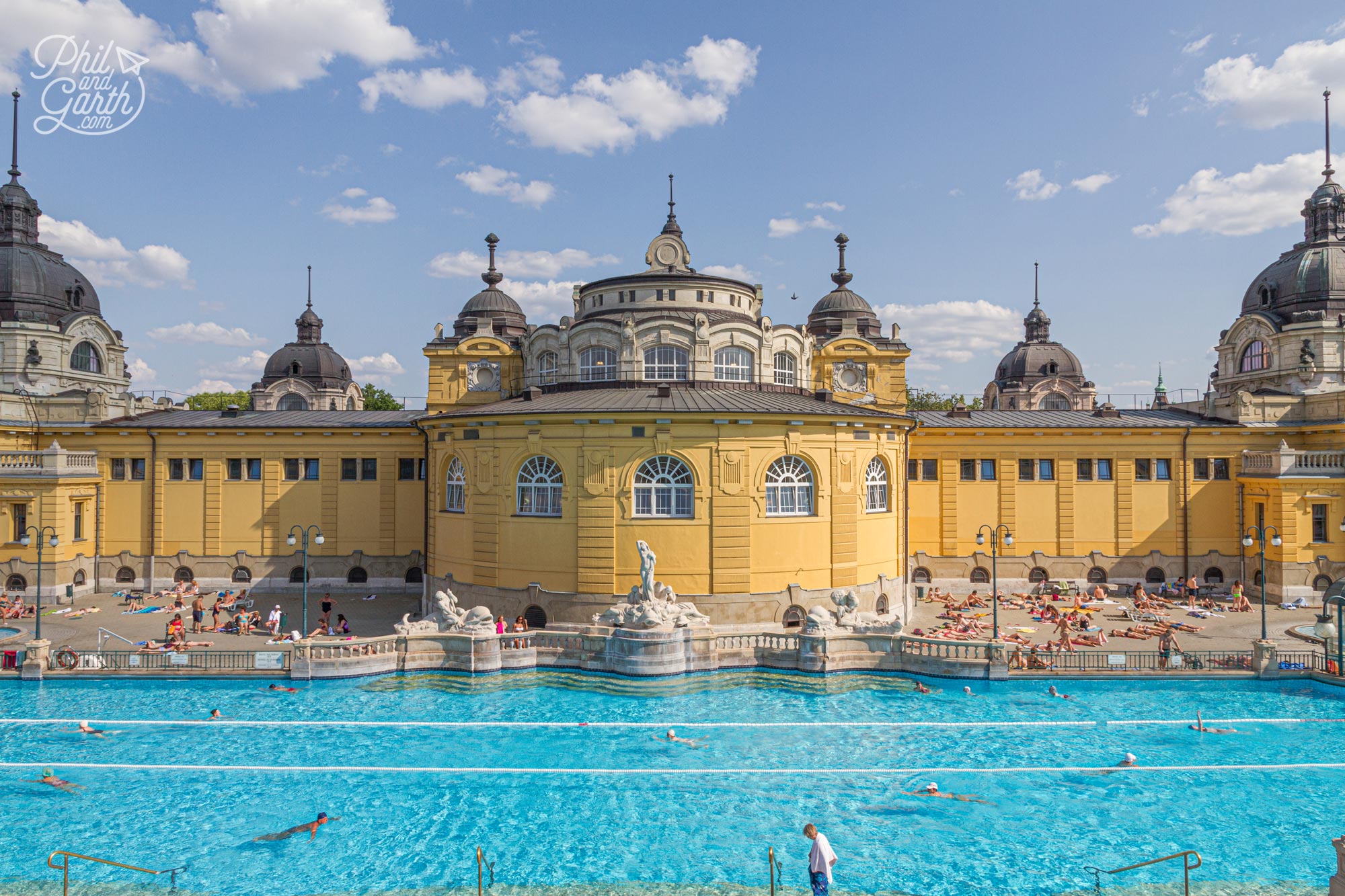
The Széchenyi Baths is a must do whilst you spend 2 days in Budapest

The Széchenyi Baths was built in 1913 and is the largest thermal spent bath complex in Budapest

Guys playing chess at the Széchenyi Baths

The bubbling hot spring water is rich in minerals like sodium, calcium and magnesium
The Gellért Spa
On the Buda side of the city is perhaps the most prestigious bath in Budapest – The Gellert Spa. We loved this place, it oozes sophistication and is just gorgeous with all the Art Nouveau tiles, sculptures and mosaic walls, it really is an Art Nouveau palace. The Gellért Spa was built in 1918 and features a stunning main swimming pool with an upper gallery and a glass roof. Outside there’s an open air swimming pool with artificial waves. Our favourite pools were the indoor thermal pools, there’s 4 pools – 2 on each side. The water is extremely hot between 36ºC – 40ºC. We were lucky and it was really quiet so we had the pool virtually to ourselves which made it feel more like a spa experience.
The water contains calcium, sulphates and chlorides which is said to heal and soothe your body. It certainly felt like it was working as we both just sat relaxing in the really hot water. The Gellért Spa also has steam rooms, saunas, treatment rooms for massages and spa treatments which cost extra.

The Gellért Thermal Bath is located inside the famous Hotel Gellért

The entrance to the beautiful lobby of the Gellért Spa is on Kelenhegyi Street

The elegant indoor swimming pool at the Gellért Spa
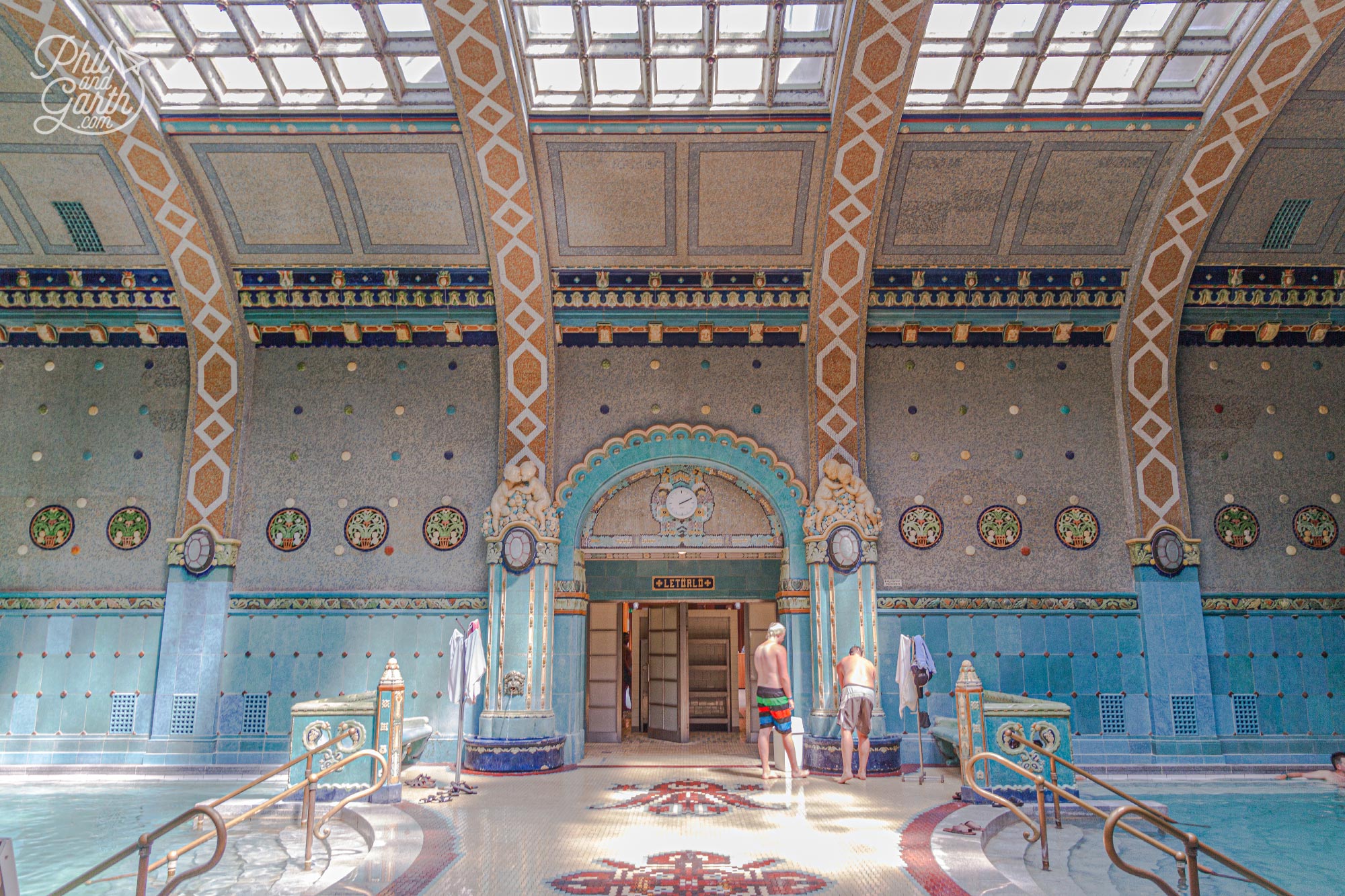
The Gellért Baths was built between 1912 to 1918
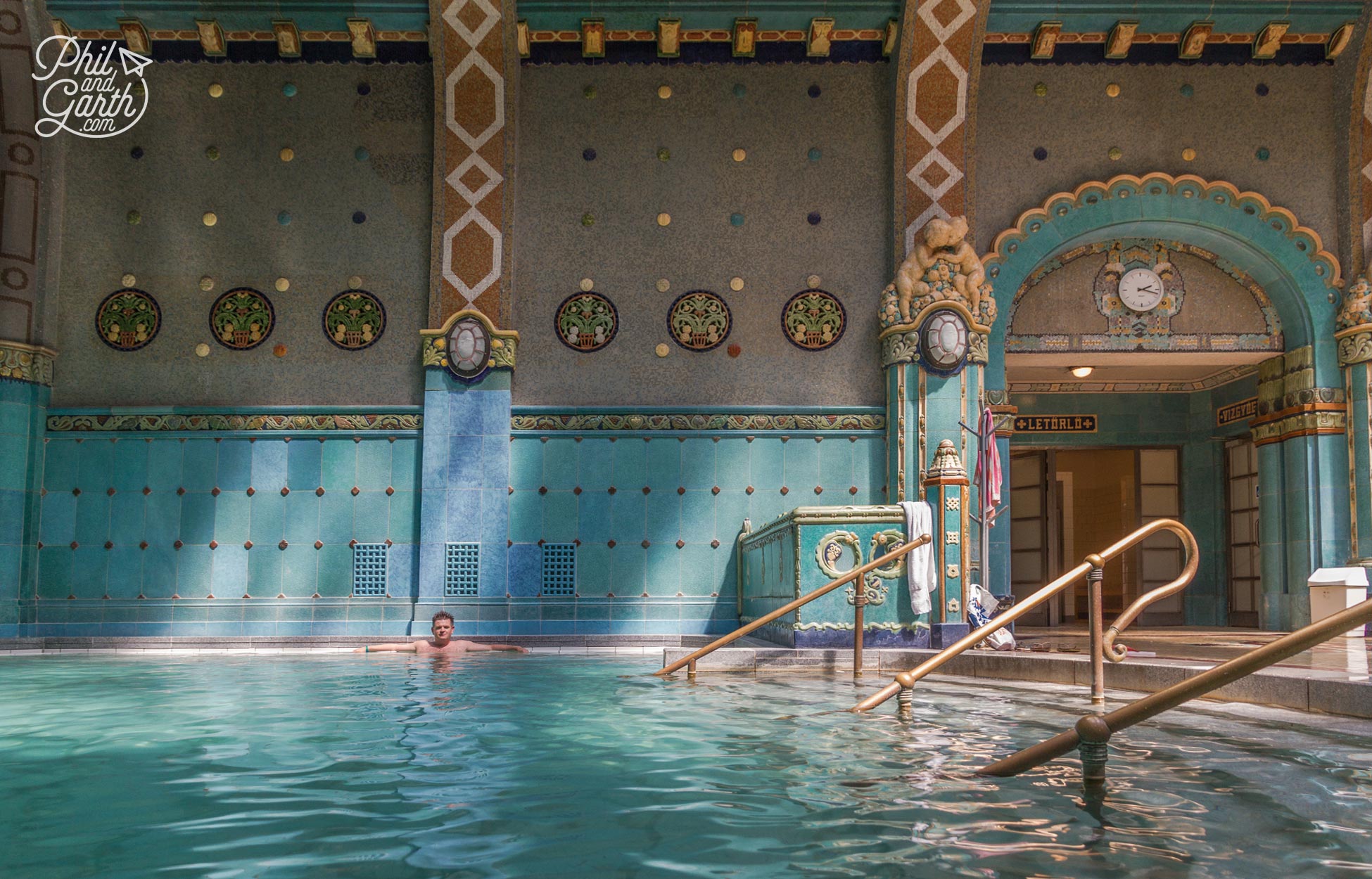
Phil relaxing in the thermal pool at the Gellért Baths

The opulent interior of the hot thermal pool

This face serves up hot water in the thermal pool

The thermal pools have the best art nouveau features

Love the colour palette of the mosaic floor designs
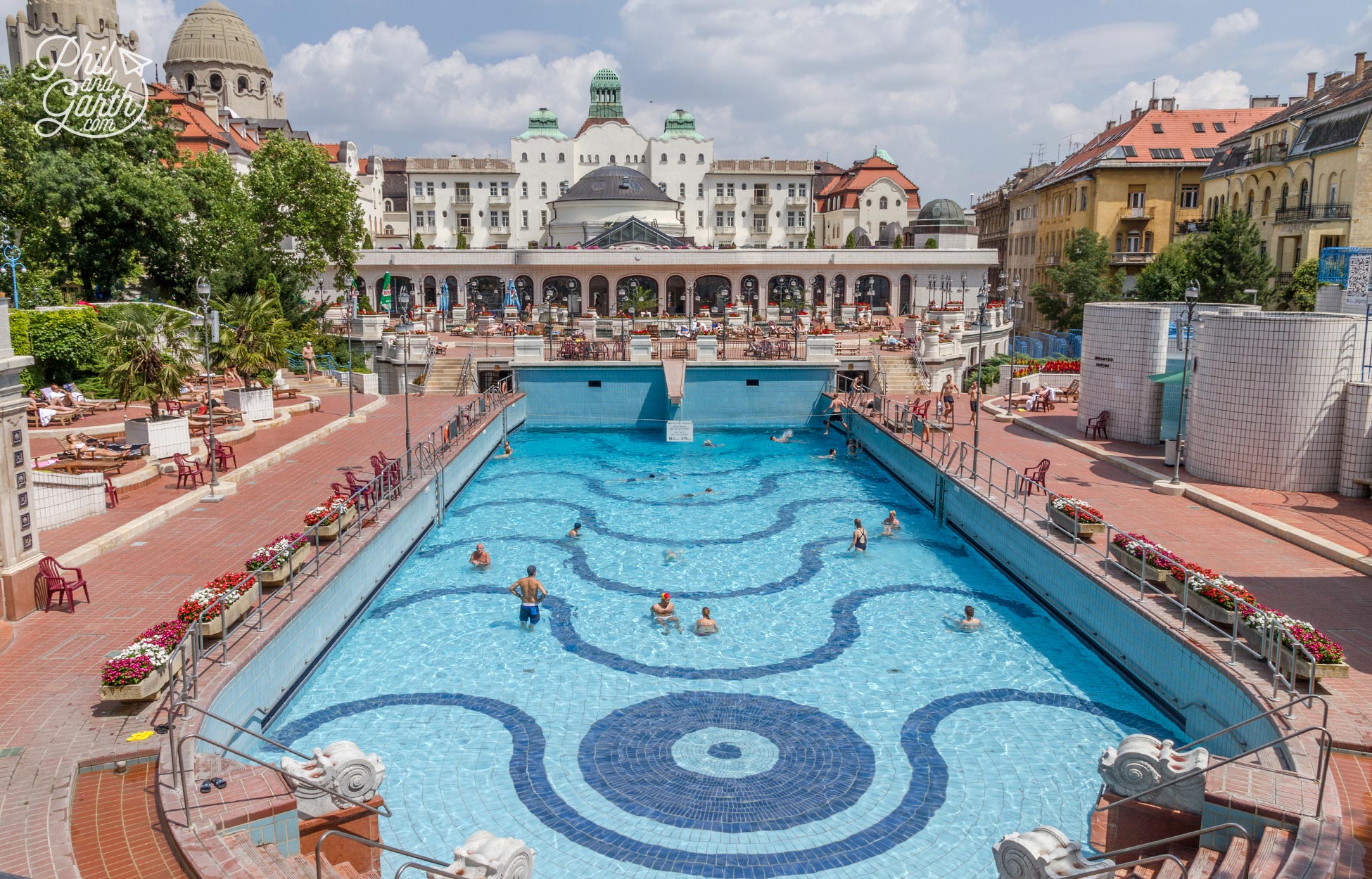
The outdoor thermal wave pool at The Gellert Spa
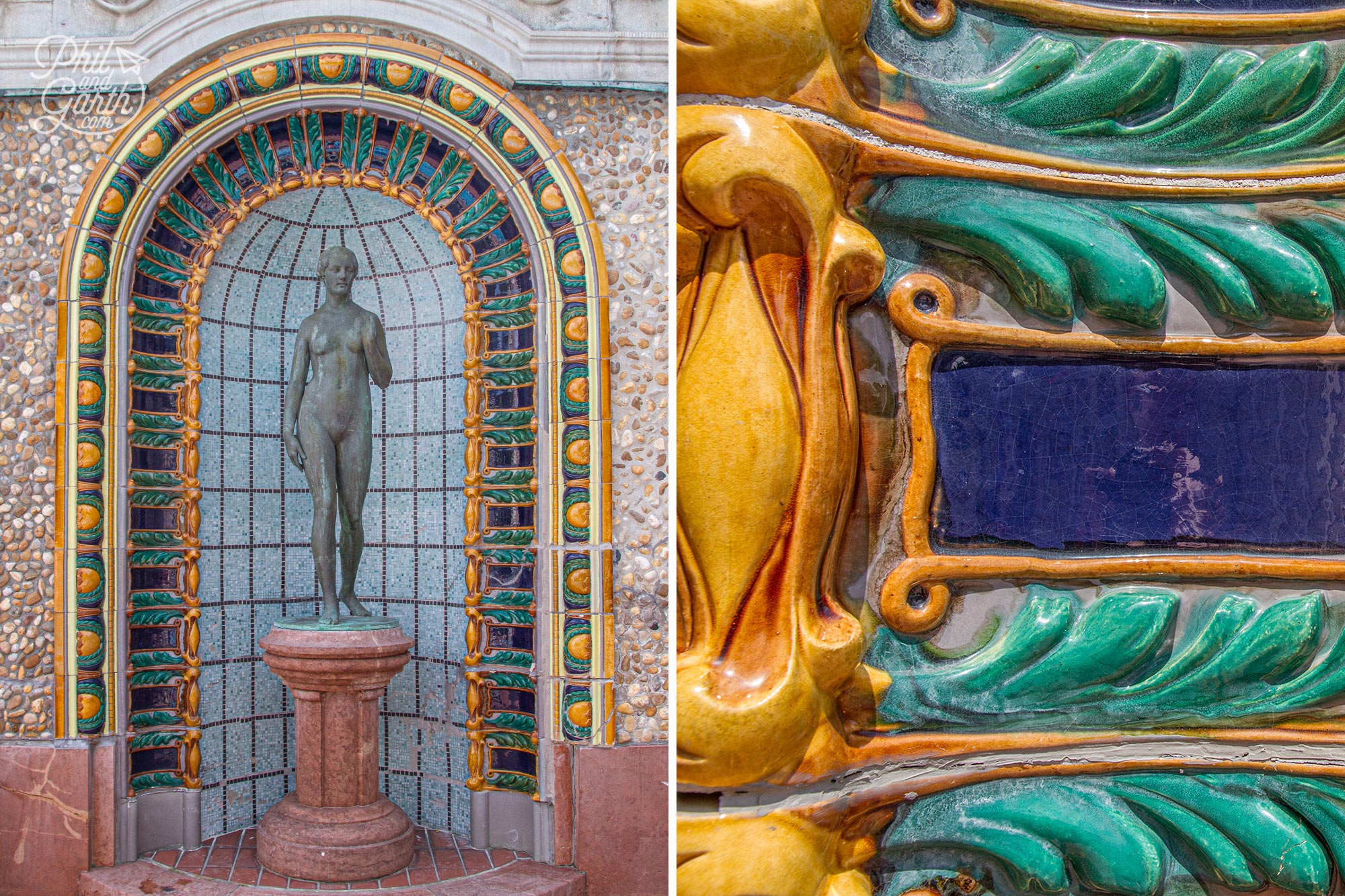
So many gorgeous design touches around the outdoor pools
Other Thermal Baths In Budapest
- Rudas Thermal Baths – 500 years old Turkish bath with a swimming pool & 6 therapy pools.
- Lukács Thermal Baths – Small baths favoured by locals.
- Király Baths – Small Turkish bath and the oldest thermal bath in Budapest.
- Palatinus Baths – On Margaret Island large open air thermal bath and pool.
- Veli Bej – Small Turkish octagonal bath in the Császár Hotel.
Budapest In 2 Days – The Best Attractions
Hungarian Parliament Building
Built in 1904 the Hungarian Parliament Building is one of the largest Parliament buildings in the world. It’s really beautiful to look at with two symmetrical facades decorated with loads of gargoyles. It was built in the Gothic Revival style. We could see the similarities to London’s Palace of Westminster which was used as inspiration. We thought it looked best viewed from a river cruise or from the other side of the Danube so you can take in the whole scale of the building. If you have time take the 45 minute tour inside to see the Crown Jewels. Book tickets on their website, you’ll need to book at least a week ahead and take your passport as proof of identity.

The monumental Hungarian Parliament Building – the 3rd largest parliament building in the world

The exterior is quite breathtaking and drew inspiration from London’s Parliament – The Palace of Westminster
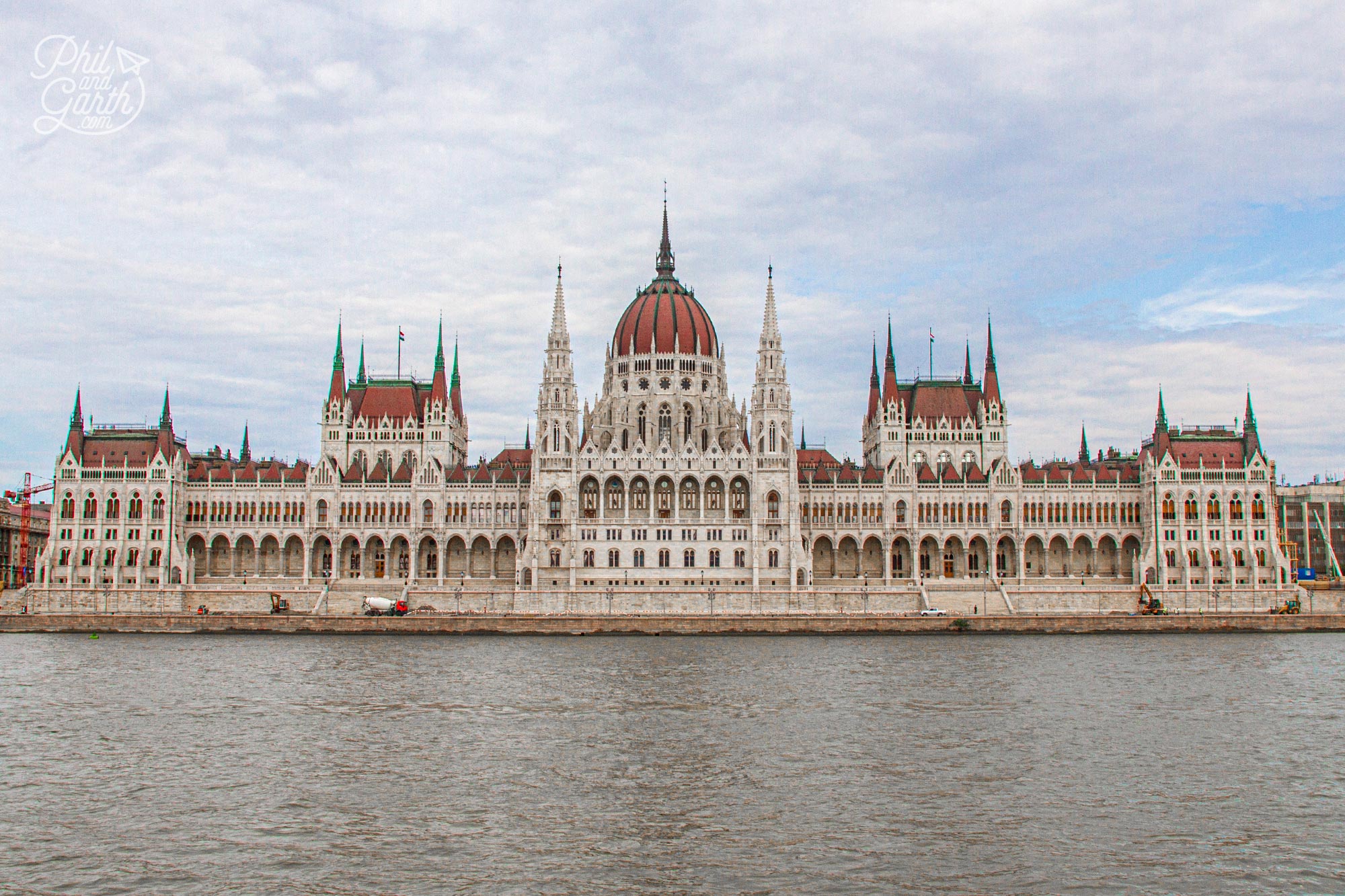
The Hungarian Parliament Building is best viewed head on from the River Danube
Shoes on the Danube Promenade
A short walk from the Parliament Building you’ll find on the bank of the Danube an incredibly moving memorial. Dedicated to the 20,000 Jews killed by Nazis in 1944 when Hitler took control of Hungary. 60 pairs of 1940s shoes made from iron represent the place where victims had to remove their shoes before facing their executioner and brutally shot dead. The leather shoes were considered valuable in war time. We found the memorial chilling but incredibly moving.

Shoes On The Danube Promenade – The haunting memorial to the Jews killed here
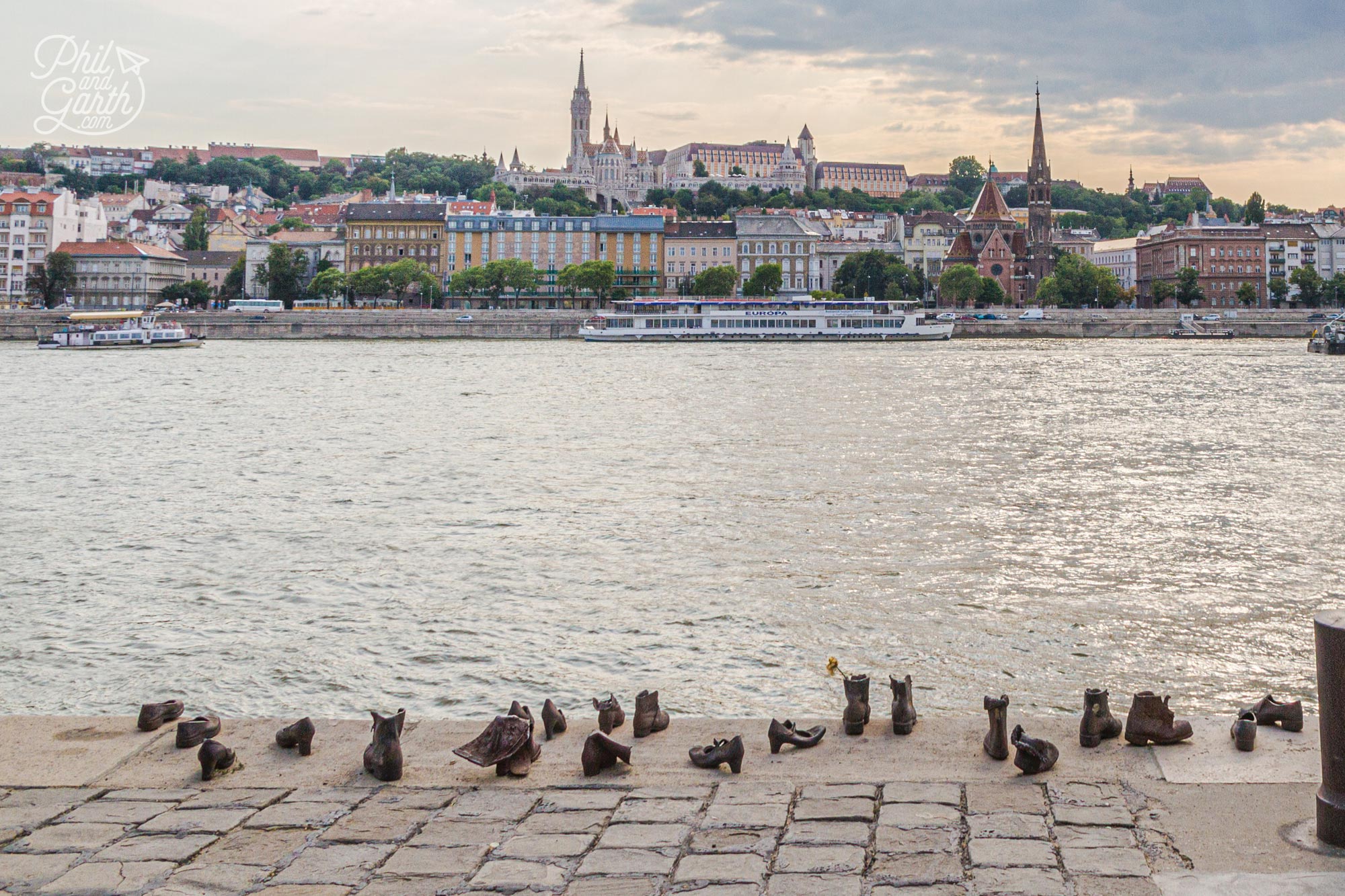
Before the Jews were killed they were ordered to take off their shoes

The memorial includes some tiny shoes of a child
The Chain Bridge
From the shoes memorial walk across The Chain Bridge which has become an iconic landmark of Budapest. Where 2 stone lions on each side have been guarding the bridge since 1850. During World War 2 the bridge was damaged by bombing and only the pillars remained, it was later restored. The name comes from the iron chains that held up the original suspension bridge.
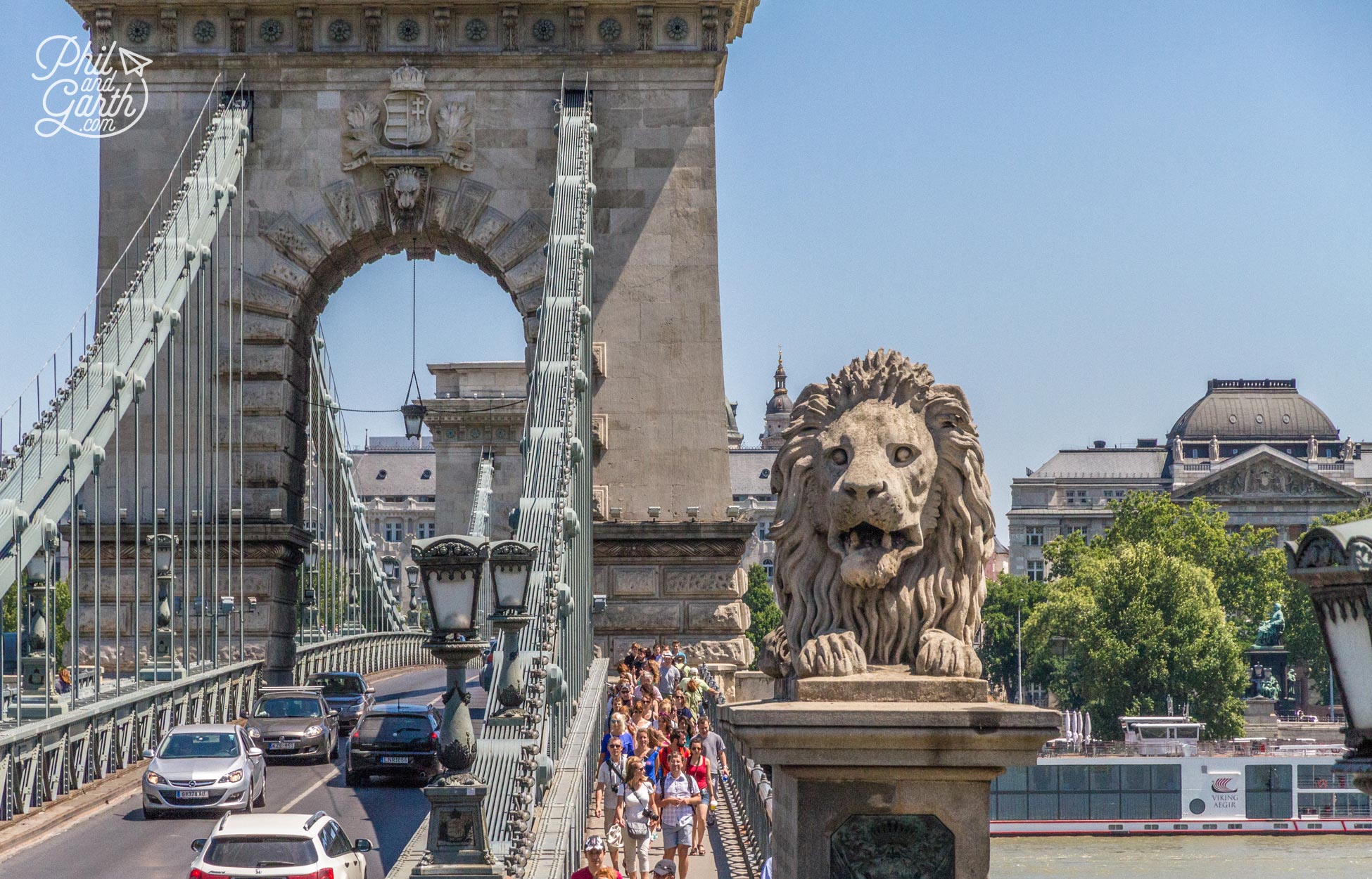
The famous Chain Bridge, Budapest

Budapest’s ladmark Chain Bridge
Danube River Cruise
Taking a sightseeing river cruise down the Danube is one of the nicest ways to see Budapest and is especially good at night. There’s plenty of companies offering cruises from the Pest side. A cheaper option is to take a public transport river bus.
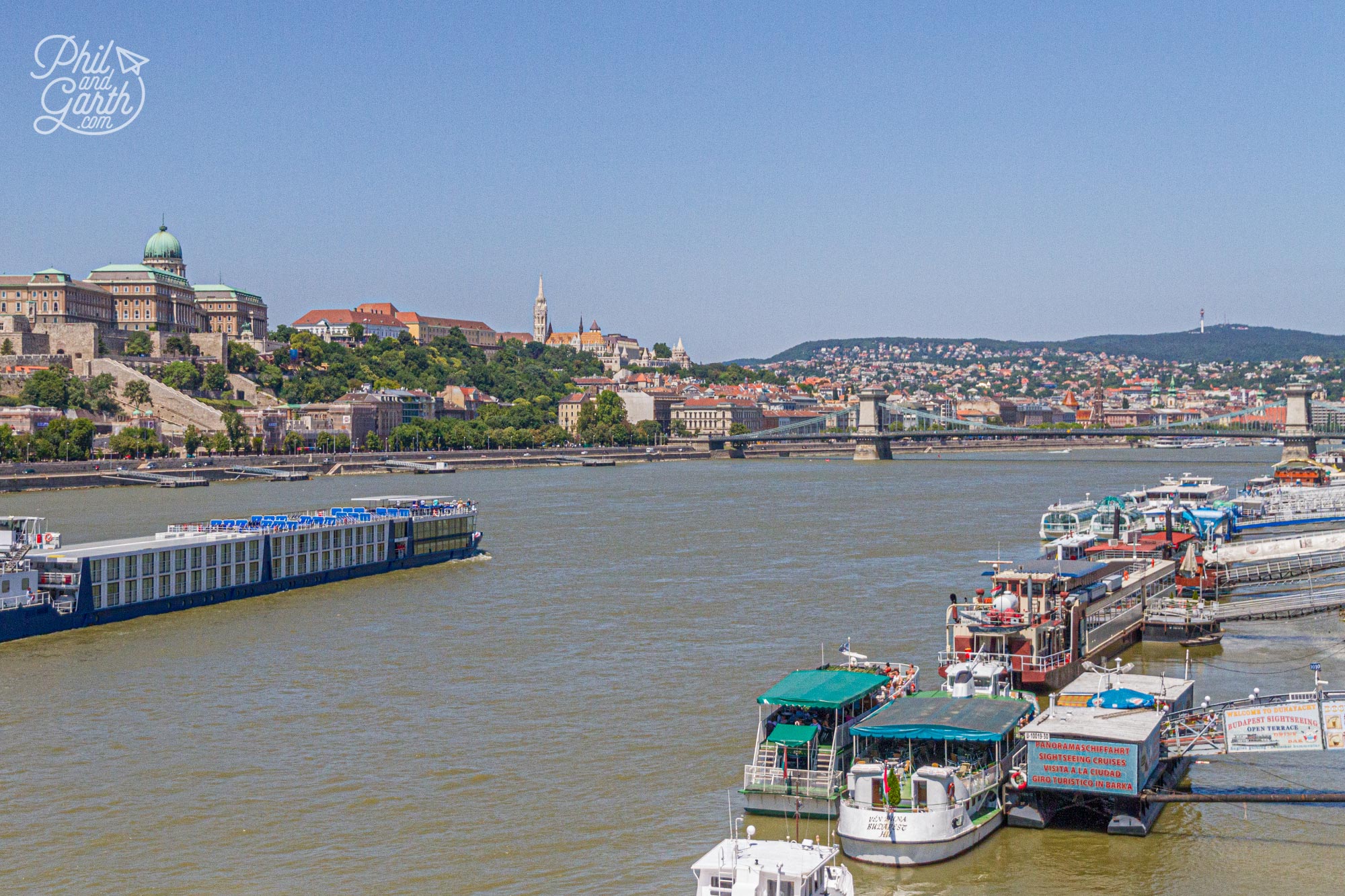
Theres lots of sightseeing river cruises to choose from
Buda Castle District
Buda Castle is a UNESCO World Heritage Site and was first built in 1265, most of what you see today was built in 1749. It used to be home to past Hungarian kings and queens. It’s much more like a palace than a castle and is often referred to as the Royal Palace. Within the castle grounds is the Castle Quarter with several areas to explore like Fisherman’s Bastion, Matthias Church and museums to visit inside the castle. To get to the top of the hill where Buda Castle is located you can walk up the steep hill or catch the Budapest castle hill funicular or just use the sightseeing Big Bus like we did.

The Buda Castle is a UNESCO World Heritage Site
Fisherman’s Bastion
Fisherman’s Bastion is fairly new by Budapest standards built between 1895 – 1902 it has some amazing views of the city as you wander around the different viewpoints within the 7 fairytale looking towers. They are free to enter apart from the upper floors which have a small charge. Fisherman’s Bastion is named after the Medieval Guild Of The Fishermen – who protected the city in the Middle Ages from these lookout towers. The views from here at night are especially good.

Fisherman’s Bastion, Budapest
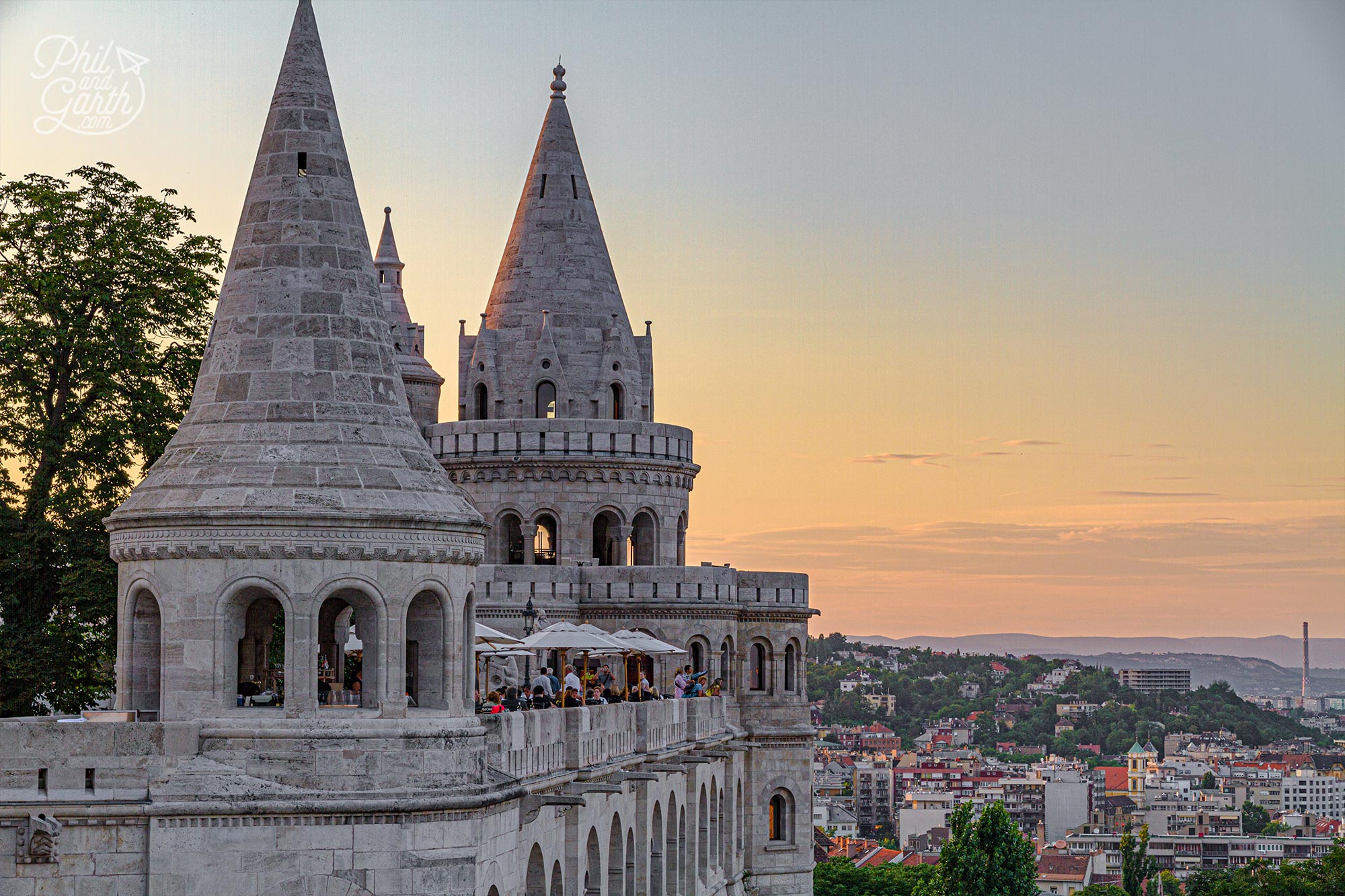
The 7 fairytale towers represent the 7 Magyar chieftains who founded the country in 895
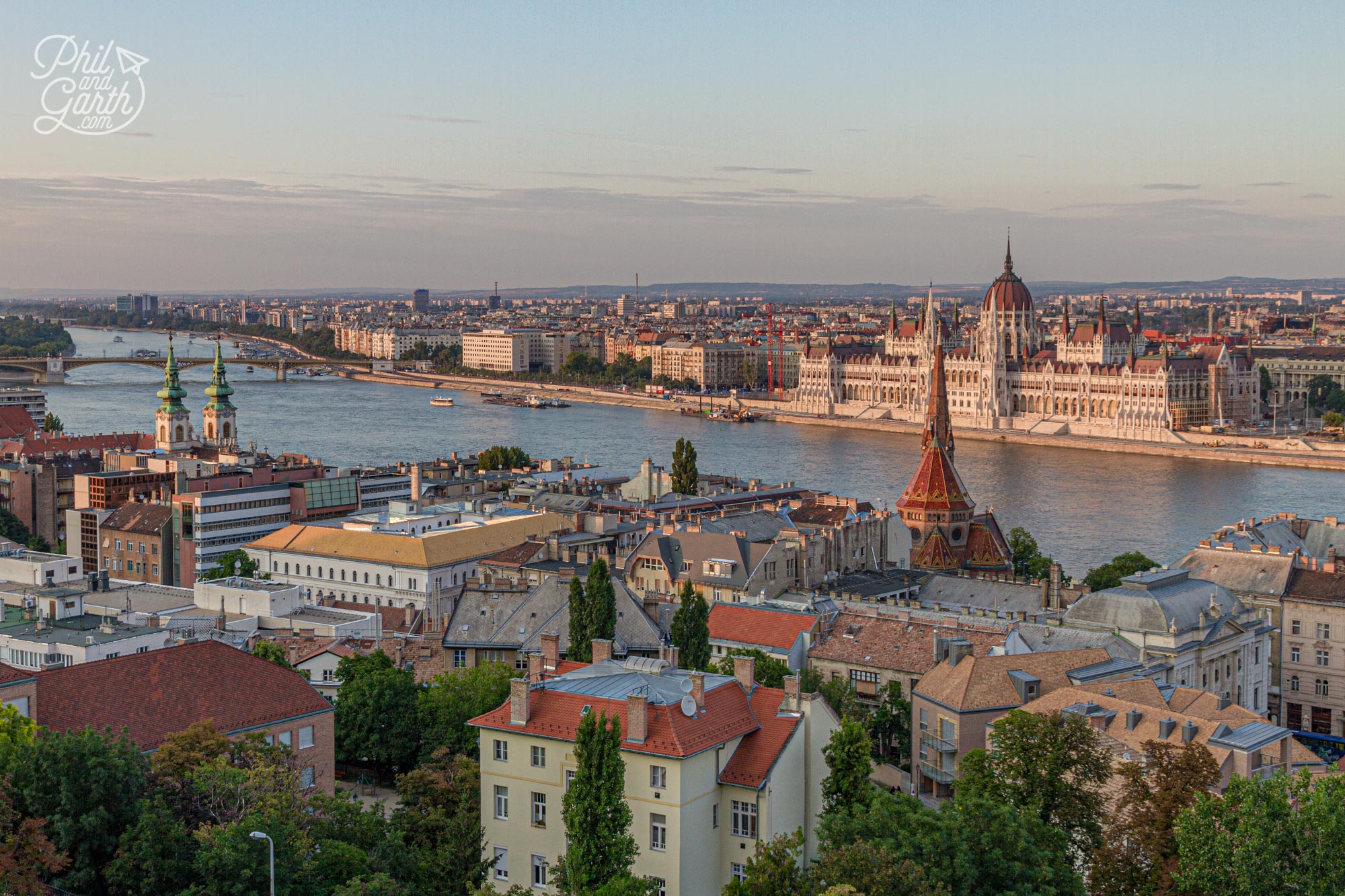
Stunning views across Budapest from Fisherman’s Bastion
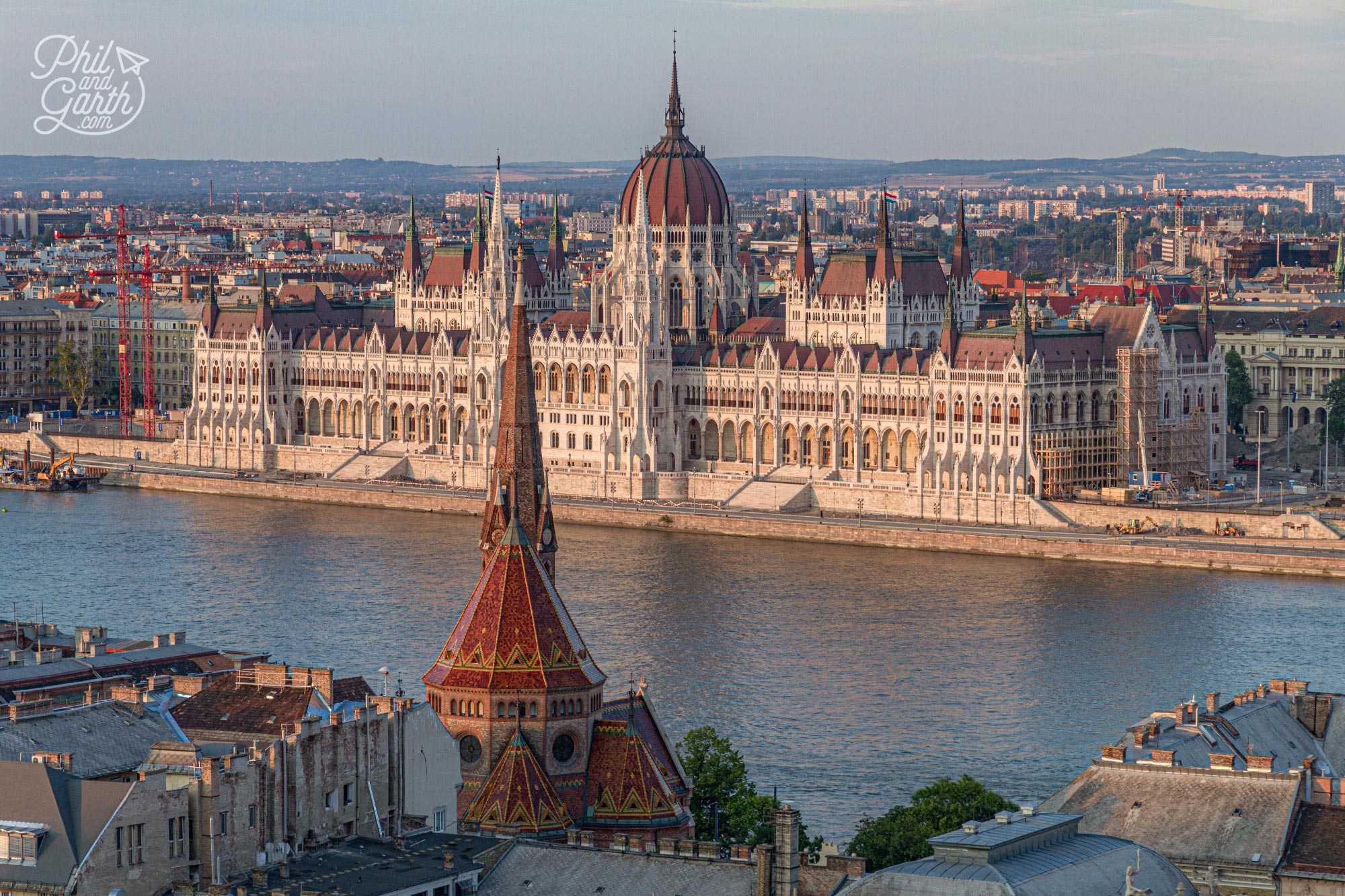
Fabulous views of the Hungarian Parliament Building from the Fisherman’s Bastion towers

Views across to the Pest side of Budapest

A view of the Hungarian Parliament Building at night from Fisherman’s Bastion
Matthias Church
Just behind Fisherman’s Bastion is the Matthias Church. It dates back to the 11th century and was rebuilt in the 15th century after the previous church was destroyed by the Mongols. Garth loved all the roof tile art – colourful designs and patterns made with traditional roof tiles. The church has quite a history from Royal weddings, coronations of Kings and was even used as a mosque for over 150 years during the Ottoman period (1541-1699). Check out the lavish interior and stained glass windows.

The majestic Matthias Church beautiful inside and out

The colourful roof tiles in geometic designs are fabulous

More of the roof tile art on the Traditional hungarian Roof tiles on the Matthias Church
Buda Castle
Inside the castle you can visit the Hungarian National Gallery (which is the national art gallery) and the Budapest History Museum across 4 floors. Another quirky museum located near the castle is the House of Houdini. The world’s best known magician and escape artist, Harry Houdini was born in Budapest and the museum documents his life with memorabilia. If museums aren’t your thing watch the changing of the guard every hour outside the presidential Sándor Palace next to the castle.

Buda Castle is a castle and palace complex that was home to the Hungarian Kings
Citadella, Gellert Hill
The main attraction from the Citadella at the top of Gellert Hill are the sweeping panoramic views of Budapest. Here you can see Budapest’s ‘Statue of Liberty’ well it’s not quite like the one in New York City. Instead Budapest’s Liberty Statue is one of the few remaining statues from the communist era. It was erected in 1947 as the Liberation Monument celebrating Soviet troops defeating Hungary’s Nazi’s during World War 2. The statue was kept and the words changed on the plaque to commemorate Hungary’s freedom from communism.

Budapest’s ‘Statue of Liberty’ stands up high on Gellert Hill

The old communist Liberation Monument became The Liberty Statue
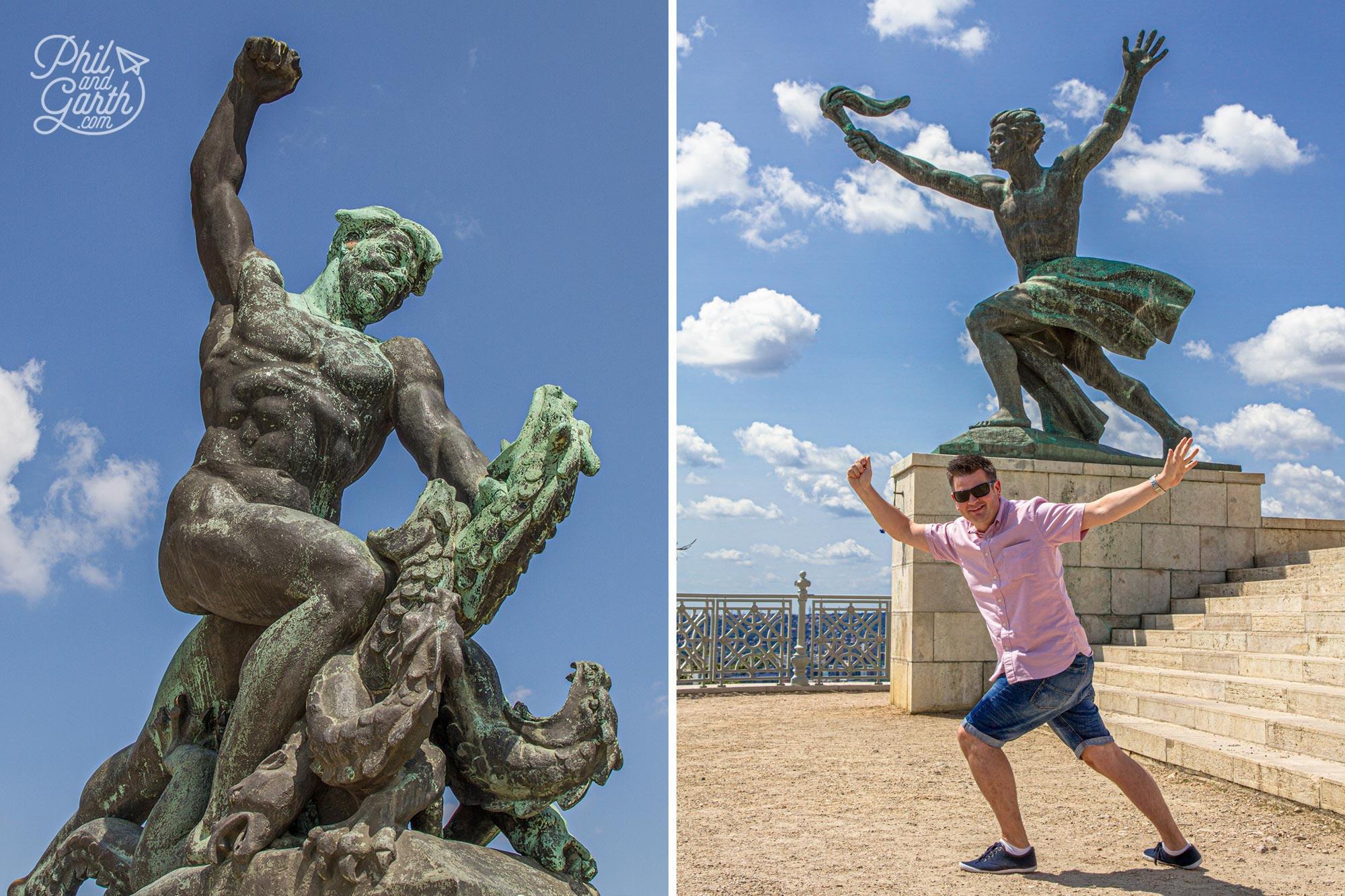
Phil with the other monuments of the Citadella

Panoramic views from the Citadella. A former walled fortress built for Austrian troops
Andrássy Avenue
Continuing our best things to see in Budapest, we walked down the classy Andrássy Avenue to Heroes Square which is Budapest’s 2nd UNESCO World Heritage Site. This is Budapest’s grand boulevard dating back to 1872. It’s like the Champs-Élysées in Paris with posh designer boutiques, fine cafes, embassies and old mansions. Look out for the elegant Art Deco exterior of the former Paris Department store as you walk down Andrássy Avenue. We walked past the The House of Terror museum and checked out the glorious exterior of the Hungarian State Opera House which has statues of opera artists like Mozart, Puccini and Verdi.

The Hungarian State Opera House on the classy Andrássy Avenue
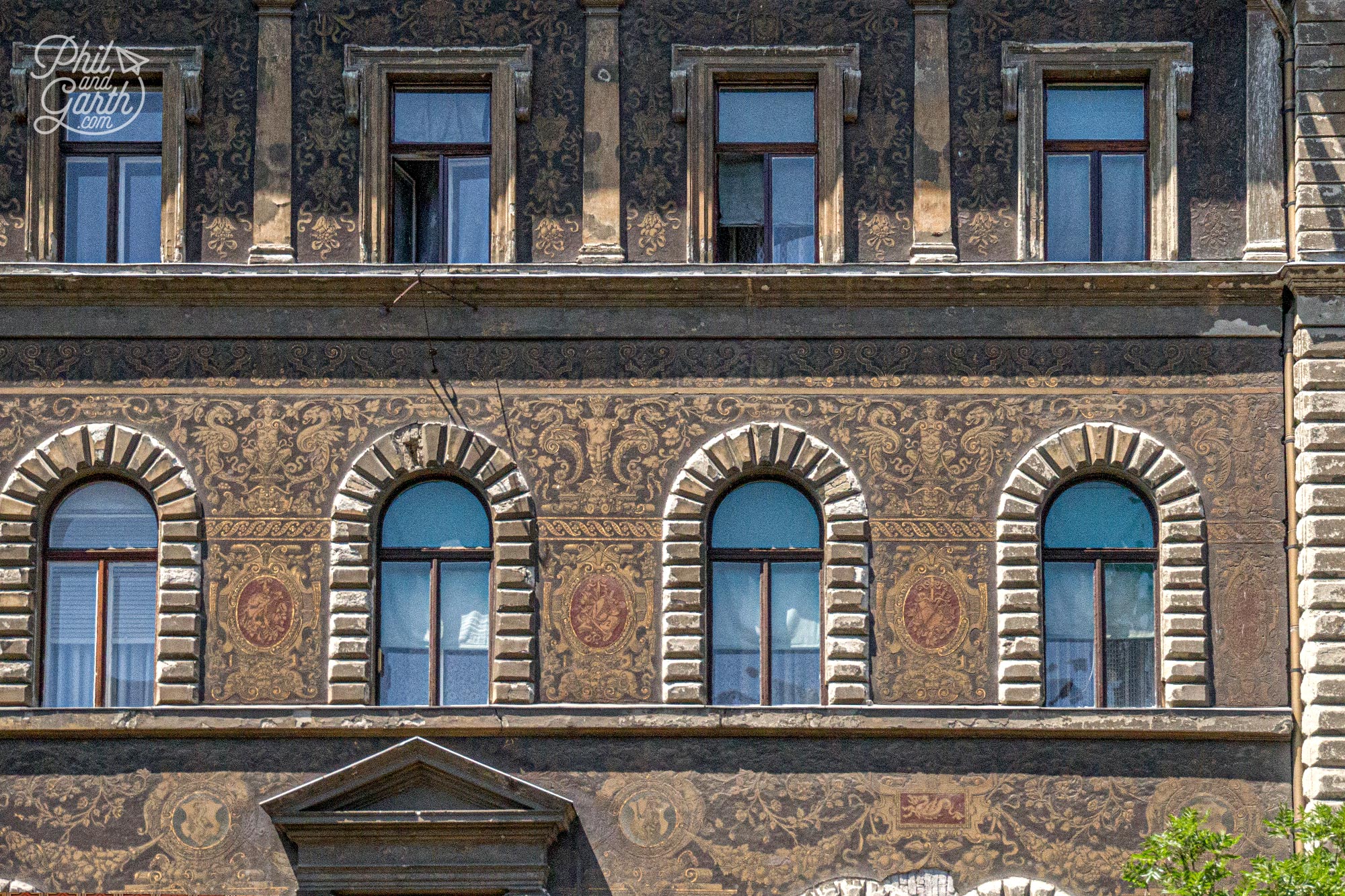
Elegant Andrassy Avenue
Coffee & Cake at Művész Kávéház
Just over the road from the Opera House is Művész Kávéház. A traditional cafe built in 1898 it has a gorgeous interior with chandeliers and huge mirrors. We stopped for a break and ordered some coffee and cake and strudel (they add 10% service charge to the bill).

The lovely Művész Kávéház cafe built in 1898 – opposite the Opera House
Heroes Square
At the end of Andrássy Avenue you’ll find Heroes Square (Hősök tere) it’s Budapest’s largest public square. Built in 1896 to celebrate Hungary’s 1,000th anniversary. In the middle is a Corinthian column with the Archangel Gabriel at the top holding the Hungarian crown, it looks like Nelson’s Column in London. Around the square are lots of statues of national heroes including Hungary’s 7 Magyar chieftains who founded Hungary in 895 (Hungarians call themselves Magyars). On either side are 2 grand buildings housing art galleries – The Museum of Fine Arts and The Palace of Arts.

Phil and Garth on Heroes Square, Budapest
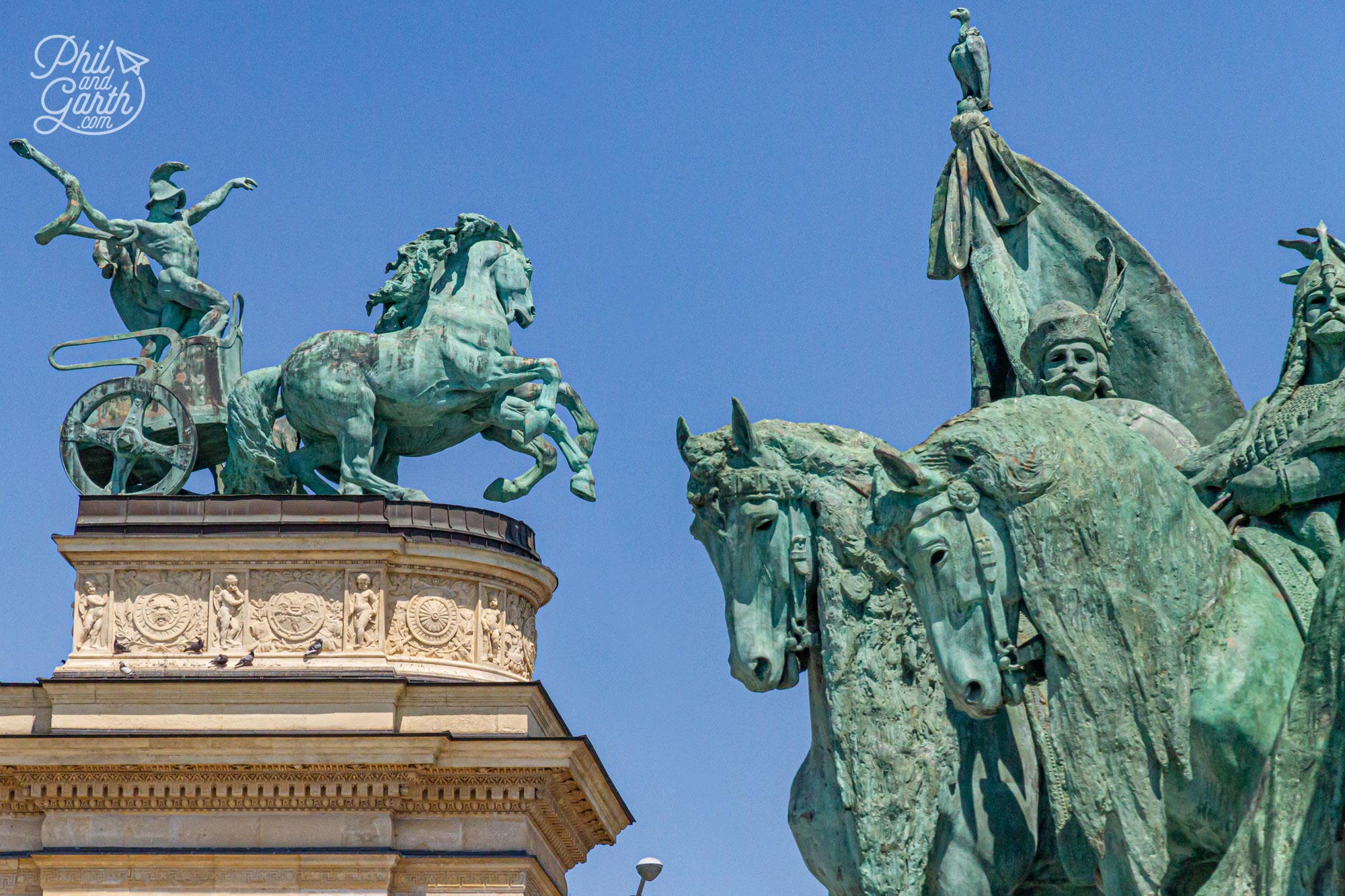
Handsome statues of statues of Hungary’s national heroes

Heroes Square is the largest square in Budapest
City Park
Keep walking through Heroes Square and you’ll enter the City Park. This is Budapest’s main public park with many attractions like the fairytale Vajdahunyad Castle, a boating lake, Budapest Zoo and botanical garden. The Budapest Zoo first opened in 1866 making it over 150 years old. Also within the City Park is another spa – a thermal beer spa which looks like great fun!

The 302 acre Budapest City Park features botanical gardens and a zoo
District 7 Ruin Bars
Not far from Heroes Square you’ll find the historic Jewish quarter also called District 7. This area is great, where you’ll find trendy and quirky bars where Budapest’s hipsters hang out in ‘ruin pubs’. Named after the run down and once disused buildings they are housed in. The bars attract an eclectic crowd inside the shabby-chic interiors sipping on cocktails and craft bars. They are a bit like the weird pop up bars you get at Glastonbury. The area is also good for street food in venues like Karavan and Gozsdu Court. If you’re into street art like Garth is, come here. District 7 is one of the best things to do in Budapest at night – the ruin bars are a hot spot for bar crawls and clubbing.

Szimpla Kert – One of Budapest’s Ruin bars
Best Ruin Bars
- Kőleves Kert – View their Instagram.
- Szimpla Kert – View their Instagram.
- Instant Fogas – View their Facebook page.
- Mazel Tov – View their Instagram.
- Doboz – View their Facebook page.
- Grandio – View their Facebook page.
Grand Synagogue
Also located in District 7 is Europe’s largest synagogue and the world’s second largest after the Belz Great Synagogue in Jerusalem. Built in 1854 it can accommodate 3,000 people. Next door is the Hungarian Jewish Museum and Archives where you can learn more about Budapest’s Jewish ghetto.

Budapest’s Grand Synagogue is Europe’s largest synagogue
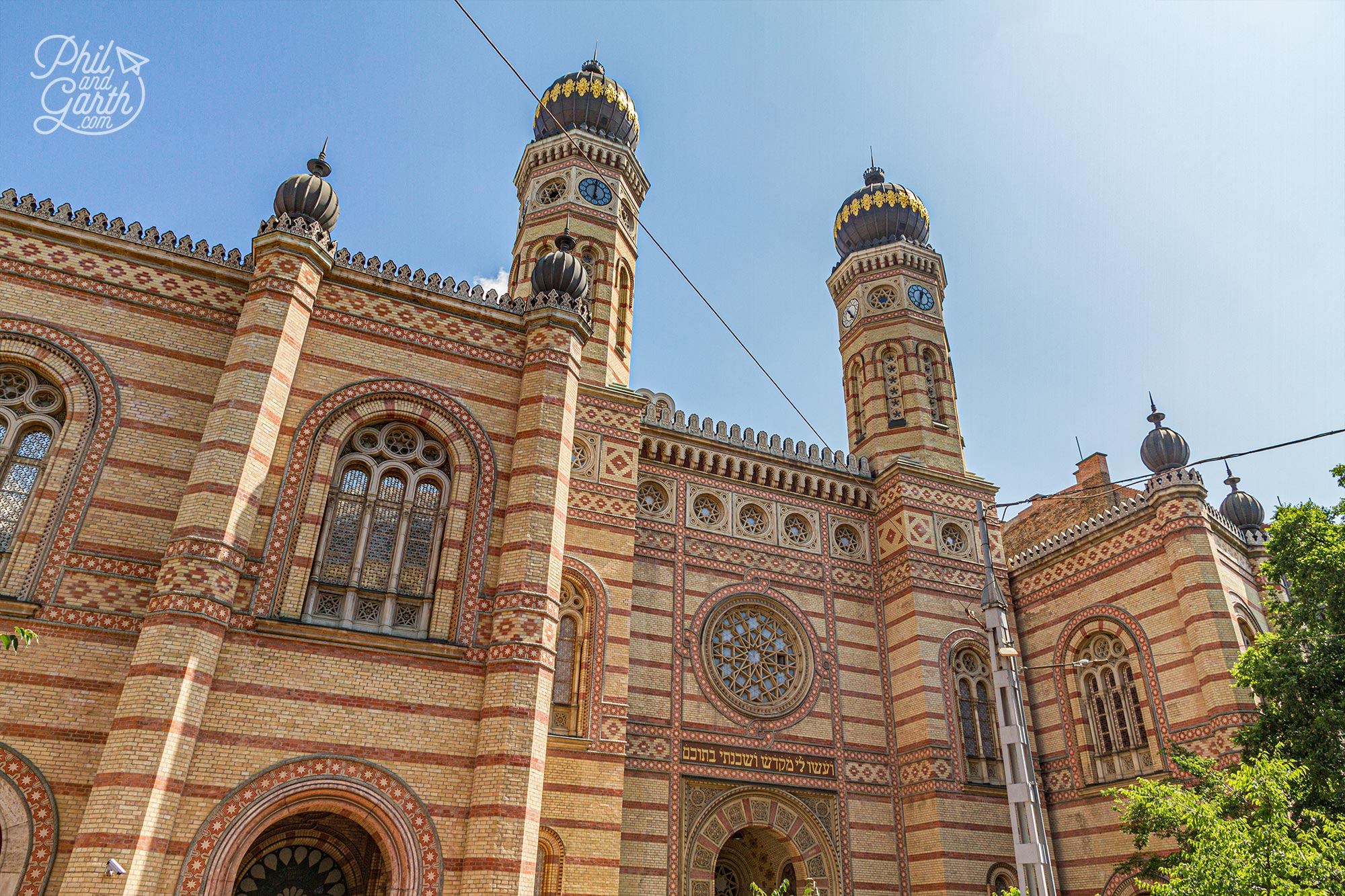
The Grand Synagogue
St. Stephen’s Basilica
The Szent István Bazilika is named after Hungary’s first Christian King, Szent István. It’s one of the most religious buildings in Hungary because it holds a holy relic. Go inside to see a gold box containing the King’s embalmed right hand. The interior is ridiculously opulent with frescoes and mosaics on the dome. Knees and shoulders must be covered when entering. One of the highlights here is to take the lift or climb the 370 steps to the bell tower for incredible views over Budapest.
Make sure you rub the brass belly of the policeman statue in front of the church. It’s said you will never put on weight again! we rubbed his tummy very hard! The surrounding neighbourhood has some nice restaurants where we stopped off for a beer.

St. Stephen’s Basilica was completed in 1905 and took 50 years to build
Just behind the church is a fun attaction for couples and families, the 3D Gallery Budapest. It’s an interactive 3D art gallery where you get to be a part of the paintings. Great for taking fun photographs for your social media.
The Best Museums In Budapest
- House of Terror Museum – Learn how people survived Budapest’s brutal Nazi and Communist rule.
- Memento Park – Outdoor museum with gigantic communist monuments and statues from the past.
- Hungarian National Museum – Exhibits of Hungary’s history, art, archaeology and religion.
- Flippermúzeum – Pinball museum in Budapest featuring over 115 pinball machines and old school arcade games.
Eat & Drink In Budapest
The Great Market Hall
Not far form the Liberty Bridge is the Great Market Hall sometimes called the Central Market Hall. This impressive and huge indoor market space was built in 1894 and is a must for food lovers. It’s also a great place to see daily life go by as people buy their fruit, vegetables and meat. There’s restaurants on the upper floor where you can eat and enjoy some people watching. We ate lunch at Fakanál Étterem who serve up a variety of Hungarian dishes including the country’s famous goulash soup which we ordered. The Great Market Hall is closed on Sundays.

The Great Market Hall is a perfect place to stop for lunch
Guide to Hungarian Food
- Gulyás – Goulash, Hungary’s famous national dish. A soup with meat, vegetables, paprika and spices.
- Halászlé – Known as fisherman’s soup it’s made with river fish, it’s hot and spicy.
- Lángos – A bit like a pizza. Fried potato dough topped with garlic sour cream and cheese.
- Lecsó – A thick vegetable stew.
- Paprikás Csirke – A creamy chicken soup.
- Túrós Csusza – Cottage cheese noodles.
- Töltött Káposzta – Stuffed cabbage rolls with mincemeat.
- Kürtőskalács – Large twirled strip of dough covered in cinnamon sugar and cooked over hot coals.
- Almás Rétes – Apple strudel – a traditional pastry dating back to the Austria-Hungary Empire days.
- Pálinka – A fruity Hungarian brandy.
- Unicum – A herbal liqueur a bit like Jägermeister.
Our Budapest Restaurant Guide
- Százéves Étterem – Budapest’s oldest restaurant. It’s the perfect place for a romantic night out for traditional Hungarian dishes and Hungarian wine. There’s also live Hungarian Gypsy music.
- Gettó Gulyás – Another restaurant to try traditional Hungarian dishes.
- Gozsdu Court – Back in the trendy District 7 this courtyard has lots of independent eateries.
- Karavan – In District 7 this outdoor market sells various street food.
- New York Café – Stunning Italian Renaissance-style interior for fine dining and cake. It’s expensive and popular so book a table.
- Ruszwurm – 200 year old pastry shop near the Matthias Church. For homemade cakes, strudel & coffee.
- Café Gerbeaud – Another famous Hungarian pastry shop.
Getting Around Budapest By Metro
It’s pretty easy to get around Budapest by walking and using the underground Metro. It opened in 1894 and is the 2nd oldest underground in the world after London’s Underground. The Budapest Metro has 4 lines and it’s easy to use. You have to validate your own ticket at one of the orange validating machines before you step on the Metro otherwise you face a large fine by an inspector. Above ground there’s also a network of public transport trams you can use.
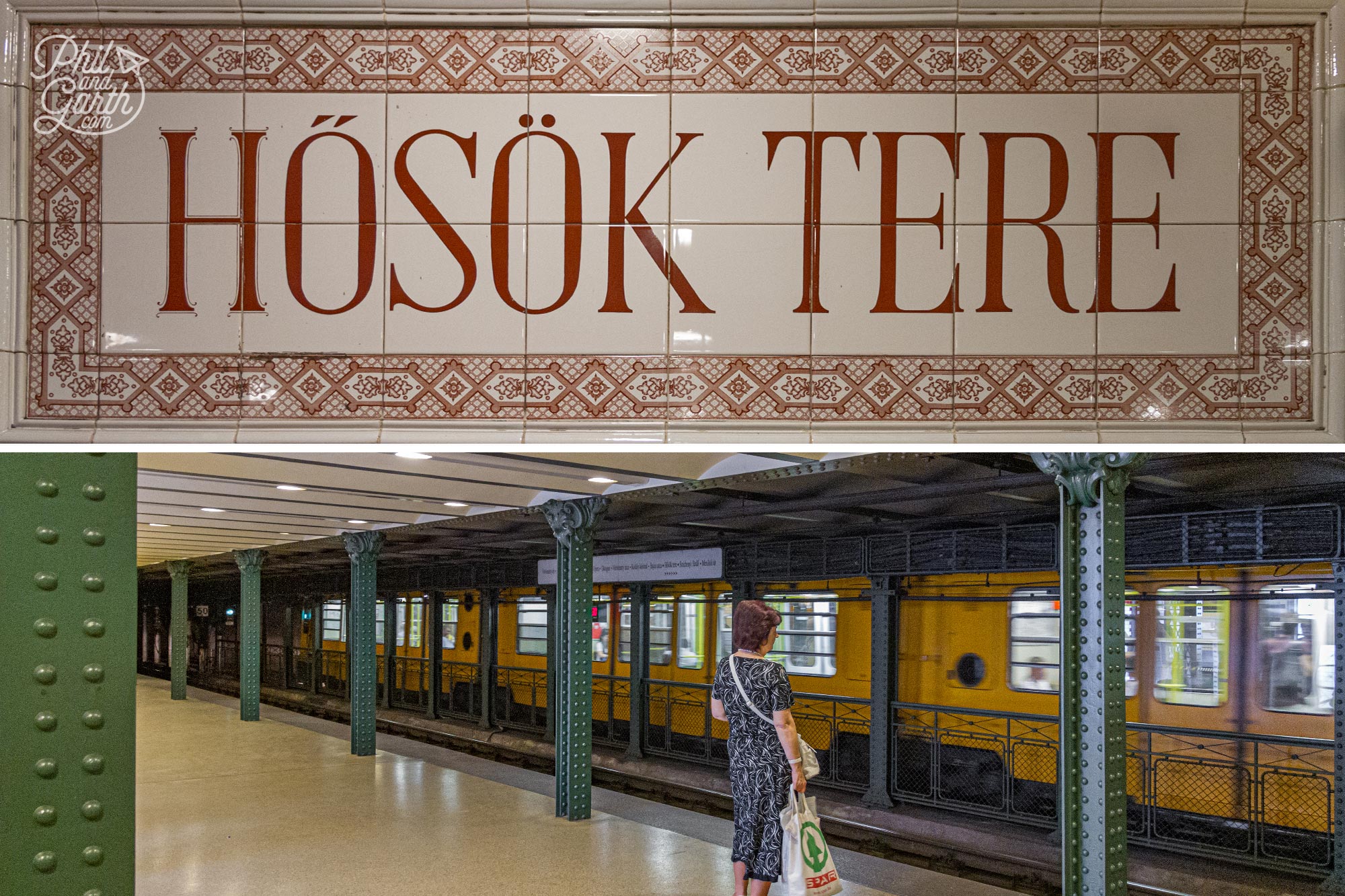
Budapest’s Hősök Tere underground Metro station
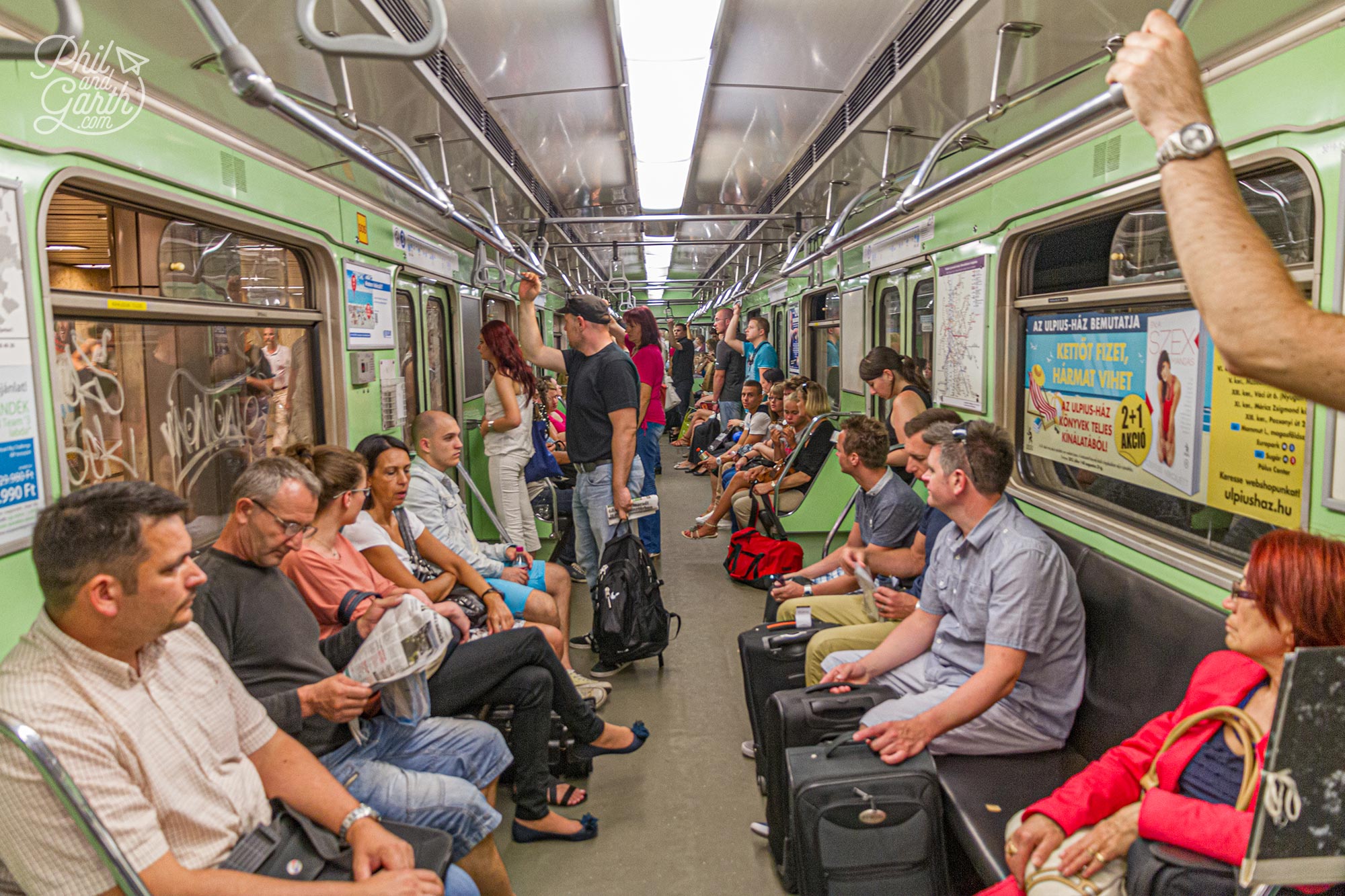
Travelling on Budapest’s undergrpund Metro is an easy way to get around

Budapest also has lots of trams to get around the city
Budapest Practical Information & Useful Advice

Phil and Garth’s Top 5 Budapest Tips
Phil and Garth’s Top 5 Budapest Travel Tips
- Tip #1: Pack your day bag with your swimming costume and flip-flops to use in spa baths.
- Tip #2: You can rent towels, swimsuits and swimming caps from spas, but they are expensive.
- Tip #3: Visit Fisherman’s Bastion first thing in the morning before the tourists arrive.
- Tip #4: Stay on the Pest side to be close to shops, restaurants and nightlife.
- Tip #5: Got more time? The capital of Austria, Vienna is 2.5 hours away on the motorway.
Budapest FAQ
- What is Budapest’s airport code? BUD – Budapest Ferenc Liszt International Airport.
- What time zone is Budapest? GMT +1 hour. Central European Standard Time.
- What currency is used in Budapest? Hungarian Forints (symbol: Ft)
- What language is spoken in Budapest? Hungarian.
- What is the population of Budapest? 1,768,000.
- What number should I call in an emergency? – Call 112. Alternative numbers 104 for ambulance, 105 for fire brigade & 107 for the police.
- What plug type is used in Budapest?: Plug Type C & F (Europlug type). Voltage is 230V / 50Hz.
- When is the best weather for Budapest? The summer months of July and August are the best months for hot temperatures.
- When is the best time to visit Budapest? Shoulder season – March to May and September to November.
- When is the worst time to visit Budapest? December to February it’s very cold, dark and can be wet or snowy.
- What is Budapest famous for? Thermal spas, Art Nouveau buildings, Magyar wines, ruin pubs and stag & hen parties.
- What’s the history of Budapest? Budapest was created in 1873 by the merger of 3 cities – Buda, Óbuda and Pest.
- What are the 5 must see sights in Budapest? Parliament Building, Széchenyi Baths, Gellért Spa, Chain Bridge and District 7.
- What is the local food? A bowl of goulash. (see our guide to Hungarian food above)
- What is the best way to get around? Walk and use the underground Metro system.
- What’s a fun fact about Budapest? The Hungarian language is unlike any other language making it one of the world’s most difficult languages to learn.
- What movies have been filmed in Budapest? The Corinthia Hotel, Budapest was the inspiration behind the film The Grand Budapest Hotel (2014).
- Where is the best photo spot in Budapest? Fisherman’s Bastion for the cityscape views.
- Where is a hidden gem in Budapest? Margaret Island.
- What’s the best souvenir to buy in Budapest? Hungarian paprika.
- How many days in Budapest do I need? Two days in Budapest is enough to give you a good overview of the city. 3 days would be even better so you can visit more museums like the outdoor Memento Park.
How We Did It:
- We stayed at the Promenade City Hotel – a basic 3 star hotel but right in the heart of the main shopping street on the Pest side.
- We took our old favourite the Big Bus Tour to familiarise ourselves with Budapest. It also includes a 1 hour river cruise.
- We visited at the beginning of July.
Google Map of Budapest Attractions
2 Days Budapest Itinerary
- Day 1: Walk over the Chain Bridge early morning and take the funicular to explore Fisherman’s Bastion, Matthias Church and Buda Castle. Head back over to the Pest side for lunch. After lunch walk down Andrássy Avenue to Heroes Square. Then spend some time in City Park before having a relaxing few hours at the Széchenyi Baths. In the evening have dinner in District 7 or choose a posh restaurant from our guide above.
- Day 2: Early morning head over to Gellert Hill to see the panoramic view of Budapest and then relax in the Gellert spa for the rest of the morning. Walk over the Liberty Bridge for lunch at the Great Market Hall. After lunch its a short walk to the promenade for where you can take a 1 hour river cruise. Then go to St. Stephen’s Basilica, visit the Parliament building and the shoes on the Danube memorial. In the evening head to the ruin bars in District 7 for dinner and a pub crawl.





2 comments
Also take a swimming hat if you wish to swim in the main pool at szechenyi baths. They blow a whistle if you are not wearing one. The others pools, you don’t need one.
Great tip! thanks for that one!